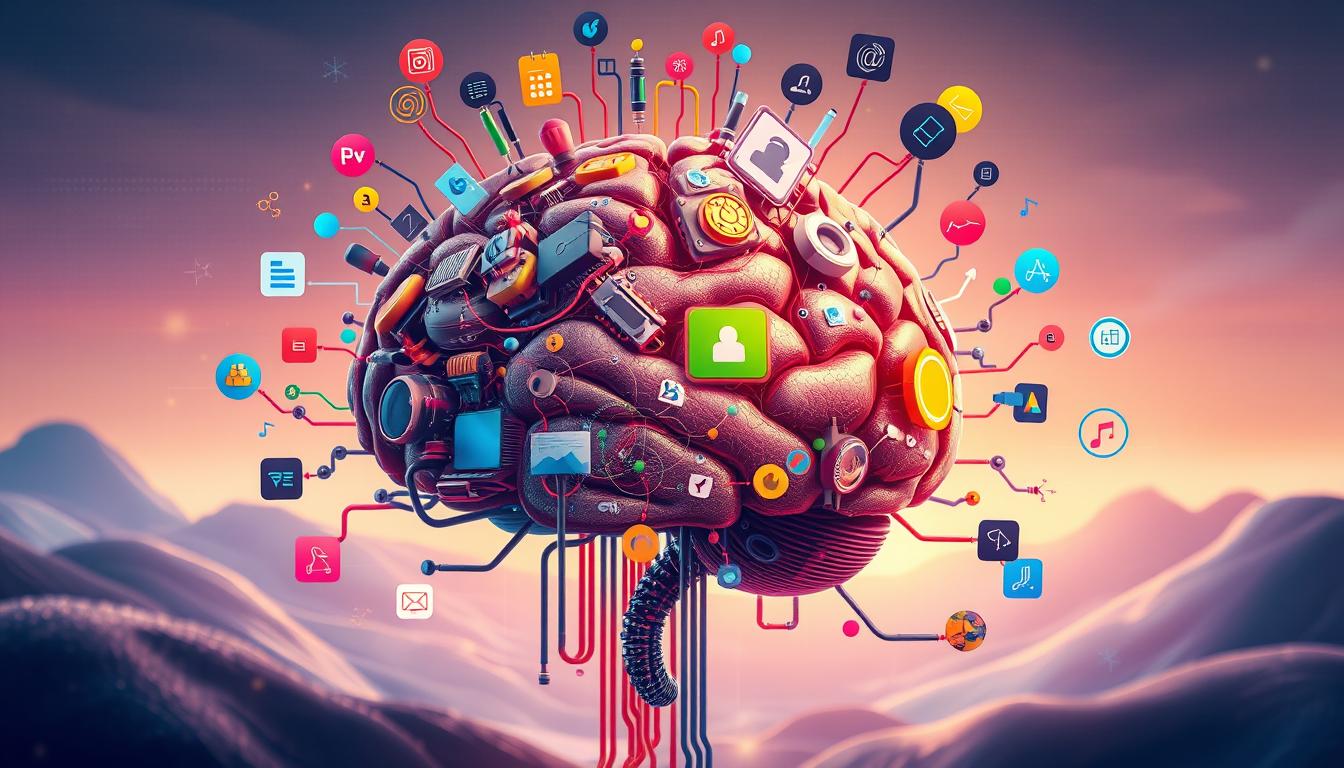Imagine a world where machines can learn and make decisions by themselves. It sounds like something from science fiction, but it’s real. Machine learning is changing how we use technology and many industries.
This guide will help you understand machine learning. You’ll learn about its history and how it’s used today. It’s filled with easy-to-grasp concepts that will make you curious. For more, check out this introduction to machine learning.
Key Takeaways
- Machine learning is revolutionizing industries and enhancing human interactions with technology.
- Understanding machine learning basics can open up new career opportunities in tech.
- Key learning types include supervised, unsupervised, and reinforcement learning.
- Evaluating machine learning models involves metrics like accuracy, precision, and Mean Squared Error (MSE)12.
- Applications range from predicting weather to generating content across various forms.
What is Machine Learning?
Machine learning is a key part of artificial intelligence. It helps systems learn from data without needing to be programmed. This makes machines smarter over time. It’s changing many fields like healthcare, finance, and retail by using data to solve problems.
For a deeper look, check out the beginner’s guide to machine learning3.
Definition and Significance
Machine learning lets systems learn from data and make predictions. It’s great at solving complex tasks, like understanding customer behavior or recognizing images. The AI industry is growing fast, from $7 billion in 2018 to $90 billion by 20253.
It’s changing how businesses work. In healthcare, it helps with accurate diagnoses and treatment plans. In finance, it spots fraud and gives investment advice4.
How it Differs from Traditional Programming
Traditional programming and machine learning are different. Traditional programming uses set rules, while machine learning learns from data. This lets machine learning systems get better over time, adapting to new challenges.
As industries need better solutions, machine learning’s ability to evolve is key. It’s more dynamic than traditional programming4. For more on this, check out “A Beginner’s Guide to Understanding Machine Learning, Simplified Version 2025,” a 84-page book with a 3.0 out of 5 customer review rating3.
The Origins of Machine Learning
The history of machine learning started in the 1950s. Early leaders like Alan Turing and John McCarthy set the stage. They worked on making systems that could learn and get better over time.
Early Pioneers and Theoretical Foundations
At first, machine learning aimed to make algorithms that could think like humans. Pioneers created methods to find patterns in data. Turing’s idea of a “universal machine” and McCarthy’s term “artificial intelligence” were key5.
These early ideas helped pave the way for later breakthroughs.
Development through the Decades
Machine learning has seen big steps forward over the years. By the 1980s and 1990s, new methods like neural networks and decision trees were introduced6. These allowed machines to handle vast amounts of data, leading to better analysis and predictions.
Now, the machine learning market is worth USD 36.73 billion in 2022. It’s expected to grow by 34.8% until 20307. This shows how vital machine learning has become in many fields.
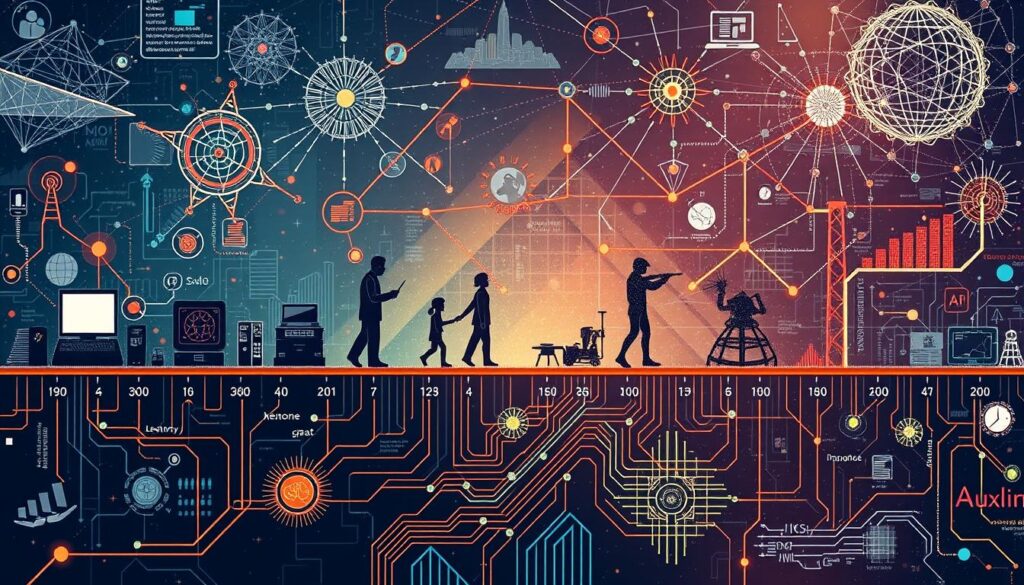
Major Milestones in Machine Learning
Machine learning has grown a lot since the 1980s. It has changed many areas of life. New algorithms and uses have made it possible to analyze data in ways we never thought possible.
Neural networks and deep learning have changed everything. They show how big data and computing power are key to machine learning.
Key Developments from the 1980s to Present
The first neural network was made in the 1940s by Walter Pitts and Warren McCulloch. The 1980s saw a big leap with the use of probability theory. This led to better algorithms and uses.
DeepMind’s AlphaGo win in 2016 showed how far machine learning has come. Tools like TensorFlow Extended (TFX) help businesses use machine learning. Models can now be 100% accurate, showing the power of computing in machine learning8
Impact of Big Data and Computing Power
Today, we make a lot of data fast. Each person creates about 1.7 MB of data per second. This gives machine learning a lot to work with.
Big data lets algorithms handle huge amounts of info well. This makes them better at predicting things. Tools like Scikit-learn and Apache MXNet help with this. They support both supervised and unsupervised learning9.Learning more about this shows how machine learning is changing tech, health, and finance.
Types of Machine Learning
Machine learning is divided into three main types: supervised, unsupervised, and reinforcement learning. Each type uses different methods to solve real-world problems.
Supervised Learning
Supervised learning trains algorithms on labeled data. This helps them make predictions based on what they’ve learned. It’s used in image recognition, medical diagnosis, and more. It’s big in finance and healthcare510.
Unsupervised Learning
Unsupervised learning looks for patterns in data without labels. It helps find clusters or structures. It’s used in market basket analysis and finding anomalies. This helps understand consumer behavior and improve operations10.
Reinforcement Learning
Reinforcement learning lets an agent learn by trying different actions. It aims to get the highest reward. It’s used in self-driving cars and personalized web services. It makes things safer and more user-friendly510.
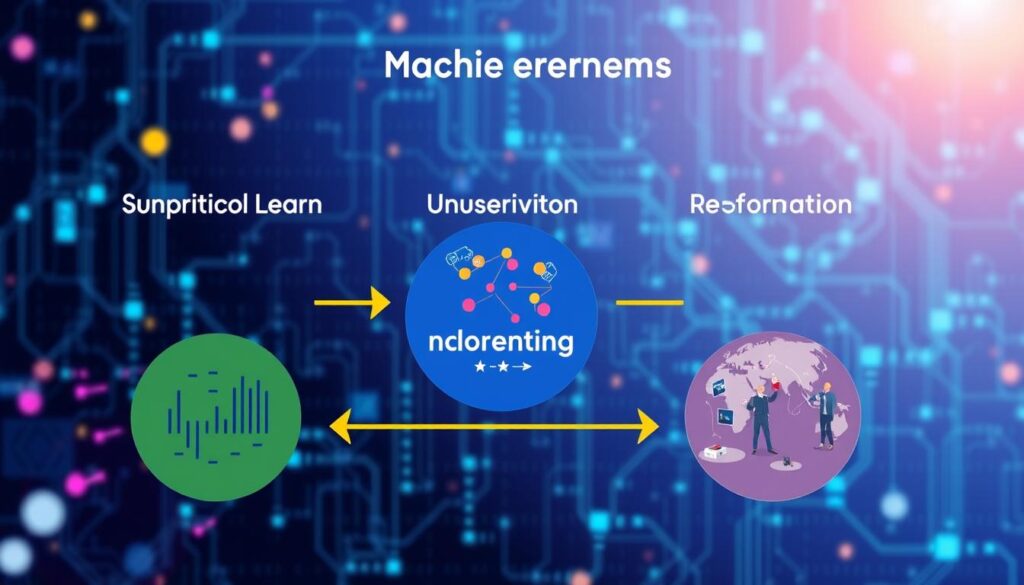
| Type of Machine Learning | Definition | Applications |
|---|---|---|
| Supervised Learning | Training on labeled data for predictions | Image recognition, medical diagnosis |
| Unsupervised Learning | Finding patterns in unlabeled data | Market basket analysis, anomaly detection |
| Reinforcement Learning | Learning optimal actions through interaction | Autonomous vehicles, personalized services |
In summary, machine learning has different types for various data analysis and decision-making needs. Each type helps drive innovation and efficiency in many industries510.
A Beginner’s Guide to Understanding Machine Learning Algorithms
For beginners, learning about machine learning algorithms is key. Each one is made for different tasks. This helps us understand how data is handled and predictions are made.
Decision Trees
Decision trees are easy to understand. They show how decisions are made and what might happen next. They’re great for tasks like finding spam emails.
They break down complex data into simple paths. This makes it easier to see the results and what they mean.
Neural Networks
Neural networks are like the human brain. They have layers of nodes that work together. This makes them good at recognizing patterns in things like images and speech.
They can learn from a lot of data. This lets them find patterns that others might miss. It opens up new possibilities for innovation.
Support Vector Machines
Support vector machines find the best way to separate data into groups. They work well in high-dimensional spaces, like with images. Their strength is in finding clear differences between groups.
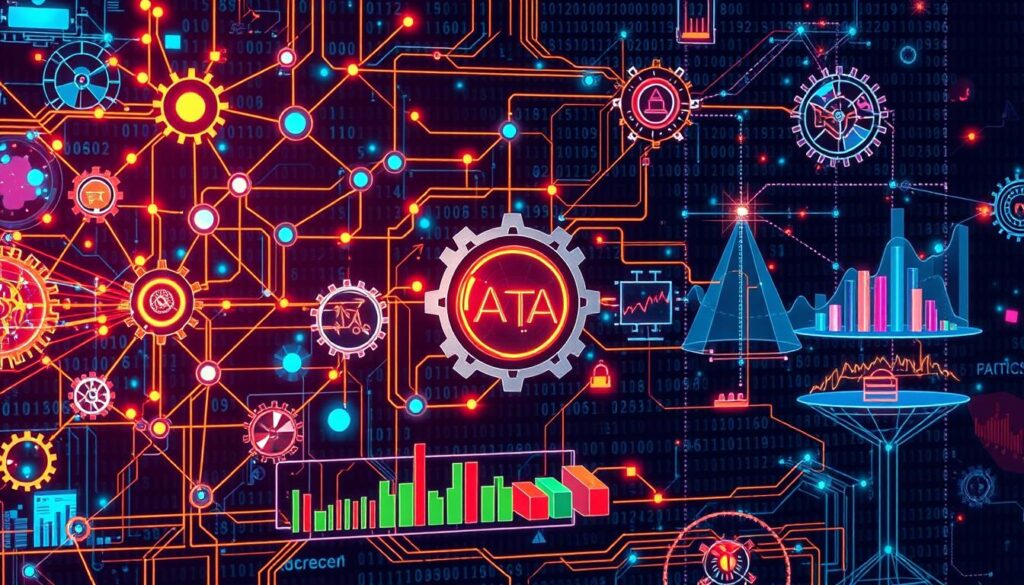
Learning about decision trees, neural networks, and support vector machines is important. It’s a big step in understanding how to make decisions based on data. For more information, check out this beginner’s guide to understanding machine learning. It covers the basics and how these technologies are used in real life1112.
The Building Blocks of Machine Learning: Algorithms, Data, and Model Training
Machine learning is built on three key parts: algorithms, data, and training models. Knowing each part well is key for success in many fields.
Understanding Algorithms
Algorithms are the heart of machine learning. They help analyze data and predict outcomes. There are many types, like Decision Trees and Support Vector Machines13.
Algorithms fall into two main groups: supervised and unsupervised learning. Supervised learning includes tasks like classifying images and predicting prices. This shows how machine learning algorithms can solve various problems14.
The Importance of Quality Data
Good data is vital for machine learning models to work well. It’s crucial for models to learn and give accurate results. High-quality data makes models more effective, helping industries succeed15.
Researchers and businesses use machine learning to understand complex data. It helps make better decisions and boosts efficiency15.
Model Training Process
The model training process has several steps. It starts with defining the problem and collecting data. Then, it moves to model evaluation and deployment.
During training, algorithms process data, make predictions, and adjust based on feedback. This cycle improves model accuracy over time. It’s key for achieving goals in many areas. The machine learning model creation guide helps through each step, leading to deployment14.
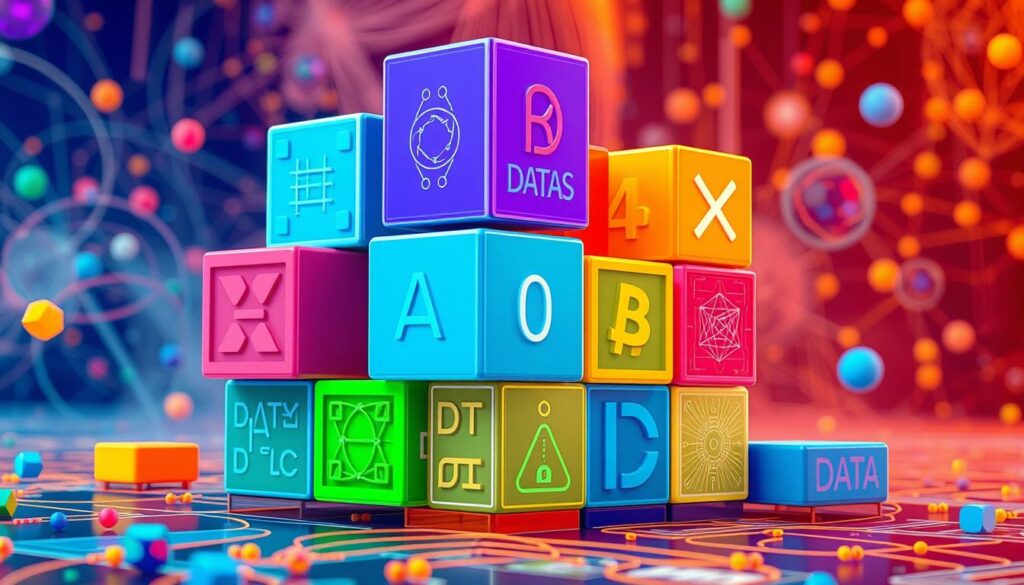
Machine Learning in Everyday Life
Machine learning is not just for tech; it’s everywhere, changing how we do things. It’s making life easier in many areas, like healthcare, finance, and shopping online. It helps us make better choices and do things faster.
Applications Across Industries
In healthcare, machine learning helps doctors find diseases early. It also helps in medical imaging. In finance, it checks if loans are safe and spots fraud. This makes money safer for everyone16.
In online shopping, it suggests products based on what you like. This makes buying things more fun and effective.
Examples of Machine Learning in Action
Machine learning is in our daily lives, like in streaming services and phone security. It helps businesses understand what customers want. This leads to better products and services17.
It’s also behind self-driving cars. These cars use complex algorithms to move safely. This shows how far machine learning has come18.
Machine learning is changing many fields. It’s key for new ideas and improvements181716.
Getting Started with Machine Learning
If you’re interested in getting started with machine learning, finding good learning resources is key. Many websites offer tutorials, courses, and materials for all learning styles. These help make machine learning easier to understand, especially for beginners.
Online courses provide a clear path to follow. Books offer deeper insights. They’re great for those who want to dive deeper.
Resources for Learning
Good learning resources are crucial for a solid machine learning foundation. Sites like Coursera and edX have courses for beginners. Knowing Python is important, as it’s widely used in machine learning.
Basic math, especially algebra and statistics, is also key. This guide explains how to use Scikit-Learn and TensorFlow. These tools make it easier for beginners to start building.
Beginner-Friendly Tools and Platforms
Using beginner-friendly machine learning tools makes learning easier. Google Colab and Jupyter Notebooks let you run Python code easily. They’re perfect for new learners.
These tools encourage experimentation and coding practice. Building machine learning models involves several steps, like data collection and training. Here’s a table showing some popular platforms:
| Platform | Features | Best for |
|---|---|---|
| Google Colab | Free access to GPUs, sharing features | Collaborative coding and experimentation |
| Jupyter Notebooks | Interactive environment, visualizations | Data exploration and presentation |
| Scikit-Learn | Simple and efficient tools for data mining | Implementing standard machine learning algorithms |
| TensorFlow | Scalable deep learning operations | Advanced models and neural networks |

By using these platforms and resources, you can learn machine learning well. This will help you develop the skills needed for success1920.
Conclusion
Understanding machine learning is key for anyone wanting to keep up with tech changes. This summary of machine learning covers different types, main algorithms, and uses in many fields. It shows how machine learning helps make better decisions and automate tasks.
In areas like healthcare and finance, machine learning’s impact is huge. It uses big datasets to get better at predicting things over time. This points to a bright future for machine learning21.
This guide also talks about important learning types like supervised, unsupervised, and reinforcement learning. Knowing these basics is a step towards a career in machine learning. The guide shows how machine learning works, from collecting data to improving models, showing its power to change industries22.
Staying committed to learning and using the right resources is important. Doing small projects and taking online courses helps grow your skills. For more info, check out this beginner’s guide to machine learning. It’s a great start for your journey into this exciting field.
FAQ
What is machine learning?
How does machine learning differ from traditional programming?
What are the main types of machine learning?
Can you provide examples of machine learning applications?
What are some beginner-friendly resources for learning machine learning?
Why is quality data important in machine learning?
What foundational elements should I understand in machine learning?
How has machine learning evolved over the decades?
Source Links
- https://concertidc.medium.com/understanding-machine-learning-a-beginners-guide-with-practical-examples-63f93573f267
- https://resources.concertidc.com/blog/understanding-machine-learning-a-beginners-guide
- https://www.amazon.com/Machine-Learning-Ultimate-Beginners-Understanding/dp/172382125X
- https://eminebozkus.medium.com/machine-learning-101-a-beginners-guide-to-understanding-the-basics-d8a85ff2c8e
- https://graphite-note.com/a-beginners-guide-to-machine-learning-understanding-the-basics-and-getting-started/
- https://mitsloan.mit.edu/ideas-made-to-matter/machine-learning-explained
- https://phaxis.com/2023/12/07/a-beginners-guide-to-machine-learning-understanding-the-basics/
- https://bostoninstituteofanalytics.org/blog/a-beginners-guide-to-machine-learning-algorithms-understanding-the-basics/
- https://www.linkedin.com/pulse/beginners-guide-machine-learning-start-here-daniel-lozovsky-mba-h6trc
- https://blog.acer.com/en/discussion/1292/types-of-machine-learning-a-beginners-guide
- https://www.linkedin.com/pulse/understanding-machine-learning-beginners-guide-mohit-singh-lqe4c
- https://medium.com/@ensargnsdogdu/machine-learning-demystified-a-beginners-guide-to-ml-algorithms-bc607ea17b4c
- https://www.nocode.mba/articles/a-beginners-guide-to-understanding-ai-and-machine-learning-concepts
- https://medium.com/@sharansachin01/a-beginners-guide-to-understanding-machine-learning-ac2204b8863b
- https://www.fullstackacademy.com/blog/what-is-machine-learning
- https://www.nowadais.com/what-is-machine-learning-beginners-guide/
- https://medium.com/@ishwaryasriraman/understanding-machine-learning-and-deep-learning-a-beginners-guide-to-ai-6c5dd0151dd3
- https://rockettai.com/understanding-machine-learning-algorithms-a-beginners-guide/
- https://www.linkedin.com/pulse/complete-beginners-guide-machine-learning-artificial-jay-shyam-patel-nzo7f
- https://www.simplilearn.com/tutorials/machine-learning-tutorial/machine-learning-steps
- https://ai-eagle.com/understanding-machine-learning-a-beginners-guide/
- https://www.springpeople.com/blog/a-beginners-guide-to-understanding-machine-learning/
